Part 2: Painting the basecoat
This will be the step that takes more time to learn than any of the others - acrylic shading can be picked up pretty quickly - but learning to paint details takes a steady hand that you'll only develop over time. Don't be discouraged if your first figures don't look as good as mine - and I almost guarantee you they will not - but keep trying, you'll get better much faster than I did if you know what you're supposed to be doing. So you don't feel bad, here is a mini-gallery of some of the figures I've done, from when I started in 2004 up to the most recent ones.
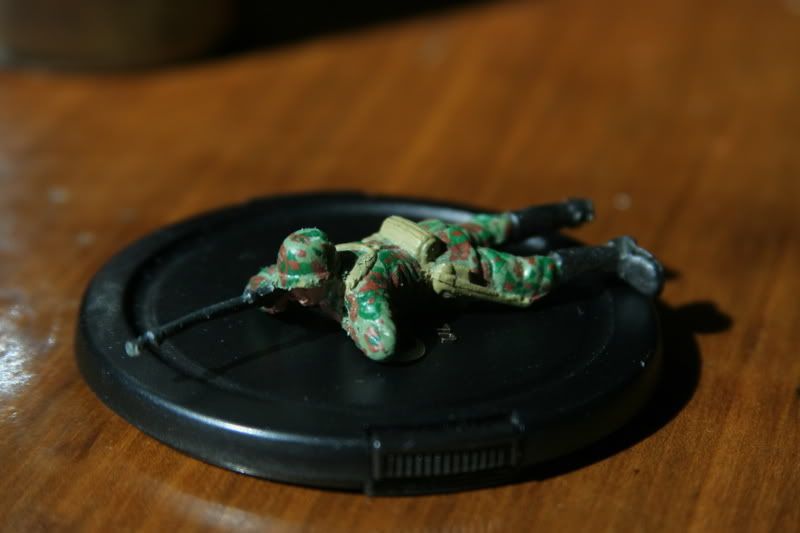
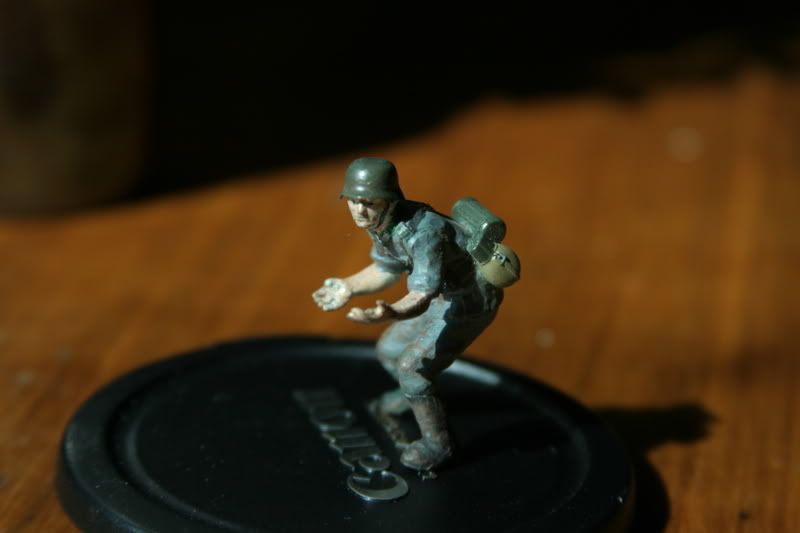


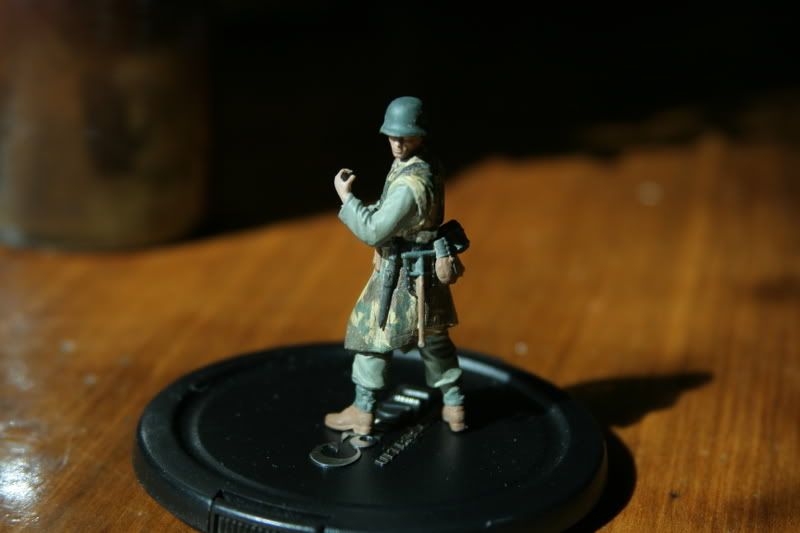
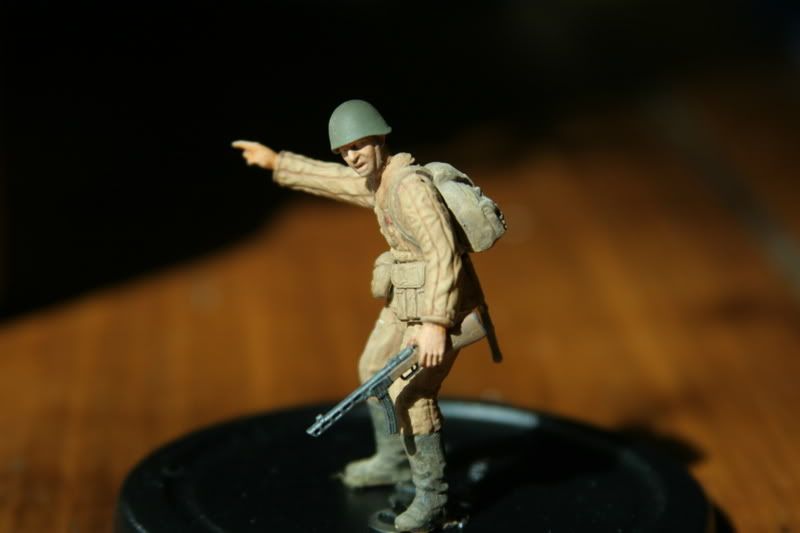


When I refer to 'painting the basecoat', I mean painting the entire figure, details included, or in other words everything you do before you start shading and weathering. There will be two major challenges with this step:
First, painting details accurately and precisely...
...and second, painting opaque, smooth color coats without leaving any brushmarks.
Detail painting can be described in enormous detail but that's still not going to make you able to do it, you must learn how by practicing. Explanation can help, though, and will make your job much easier.
My first rule for detail painting is paint from the inside out. This means you paint the center stripe on an iron cross ribbon first, the shirt underneath the jacket first, and the blacks of the eyes before the whites. Some more advanced modelers may have their own techniques for detail painting, and I respect that - but I find this one to be the easiest for beginners to use. It will be explained in more detail later.
My second rule for detail painting is don't kill yourself trying to paint precisely when you can trim it down to size later. There will be a few instances where this isn't true, but for the most part it is easier to paint the whole eye black and 'trim' it down by painting two white stripes on either side, than it is to paint a fine black line through the middle of a white eye. This rule will become clearer after you read #3.
My third rule is paint your details like you mow your lawn. This means that you shouldn't try to paint a perfect belt or strap in one pass of the paintbrush, just like you don't try mowing your lawn in one swath. Do in in rows - one side, then the other side, then the center. The same works for ultra fine detail like eyes or ribbons, when you are trying to put some color in an exact spot - you don't have to trust to luck, but rather paint the detail in swaths, pushing the paintbrush a little closer each time. If you're going inside-out, you really only need to be worried about your inside edge, because you'll paint over the outside edge with your next layer. This may seem confusing, so I'll use the Iron Cross ribbon as an example. To paint one of these, you could start by painting the whole thing white, even though only the center third is white. Then, you could paint the entire outer quarter on each side in red, even though the red stripe is between the white and the black. Finally, you'd add the black edges, trimming the red down to the appropriate size. You could even go oversize here, too, and trim the black with the uniform color.This technique enables you to worry about only one edge at a time, rather than both.
My last rule is always keep your hands/wrists braced. This is best accomplished by resting your wrists against the edge of your workbench, and makes your painting much more precise. Posture is important when painting figures and 'if you're going to be hunched over like a clerk in a Dickens novel, you'd better raise your workbench'. (Another Shep Paine quote)
The other challenge, getting opaque color coats with no brush marks, is somewhat simpler to address. The most common beginner mistakes with Vallejo paint are working the paint too much and thinning it improperly. According to many modelers, you shouldn't thin Vallejo paint because it's perfect already, but I've found that the exact thickness of the stuff varies from batch to batch. Since proper paint consistency is huge, especially for detail painting, I usually thin mine a little with warm water. Use distilled water if you live in the city - the chlorine can do strange things to paint. I usually thin mine to a consistency a bit thicker than milk, and slightly thicker for fine detail. If it won't come off the brush, it's too thick, and if it runs at all it's too thin. You should also clean your brush in warm water at least every five minutes to keep it moist and keep the paint flowing.
"No brush marks!" and "Covers in one coat!" have been the main advertising points for Vallejo ever since it was introduced. While it does level better than any paint I have seen and is very opaque, one coat is pushing it. I usually do two or three, keeping them thin and laying the paint down quickly. The two most important things to remember for basecoats (especially larger areas) are to lay the paint down quickly with a minimal amount of brushing, and not to leave any 'seams' or areas where you painted a section, let it dry, then painted the rest. Also be careful not to apply another coat to one that isn't fully dry or you will get an ugly peeling effect.
In case you are ever tempted to skip the primer coat in step one, remember this: Vallejo will not stick to bare plastic/resin. You should see your white primer coat slowly disappear as you paint each layer of the bascoat.
Now that I've covered the principles you should know, we can move on to the actual painting process.
On our example figure, I began by painting the basic skin tone and eyes. I do not shade the entire face before starting the uniform like most modelers do - I've found that my brushful of green or red always manages to find the figure's face at some point, so I prefer to leave shading until all basecoat painting is done and the risk of accidentally overpainting my carefully shaded face is minimal. Remember we glued the head only slightly, so it is removable - making painting the collar and neck a much easier task.
For Caucasian skin, I use Vallejo 021 Medium Fleshtone as my fleshtone base, with touches of 136 Red Leather, 143 Flat Earth, and 003 Foundation White mixed in. Vallejo 021 is an orangish yellow skin color, which is better that the typical pinkish fleshtone, but still needs to be toned down a bit, hence the other colors mixed in. This mixture is thinned as previously described, and applied to the face in 3-4 coats. You must be extra careful not to work the paint for more that a few seconds after you lay it on the face, or you will find ridges to shade around when you get to step 3!
Next up are the eyes. The eyes are what give a figure life - sorry to be using all these Shep Paine quotes, but here's another: 'A good face can save a mediocre figure, but a poor face can ruin an otherwise-good one'. This is the step you should take the most care in and re-do until you get it right.
Many modelers don't believe in painting whites because you can't see them on a person in the same scale (one standing about 20-25 feet away). However, I would contend that whites are important on all figures 1/35 and larger, because they are what give the eyes direction. By changing where you place the pupil on the white, you can have precise control over your figure's glance - looking right, left, up or down, even cross-eyed if you wish. I've always painted whites, and I haven't heard any complaints about my (recent) figures looking unrealistic.
So, here's a pictorial step-by step for painting eyes:
I start by painting a black line from top to bottom through each eye - pretty simple:
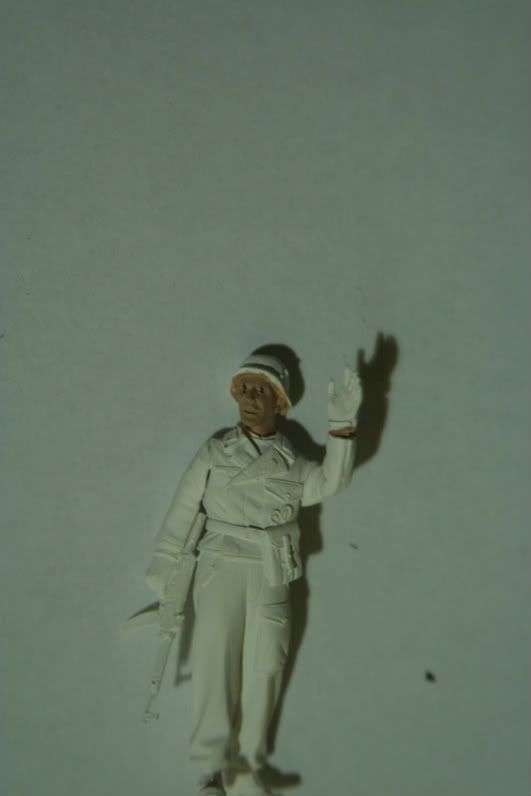
Then I trim this to a realistically thin proportion, painting in white on either side (this is the inside-outside method at work). As you can see, the border between the black and white is the only part that's precise:
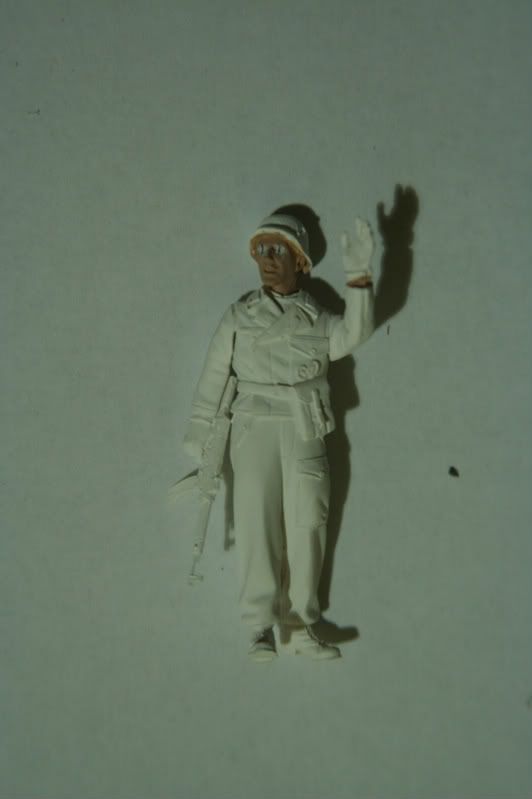
Finally, I take some of my fleshtone mixture and trim the top and bottom of the eyes down to size:
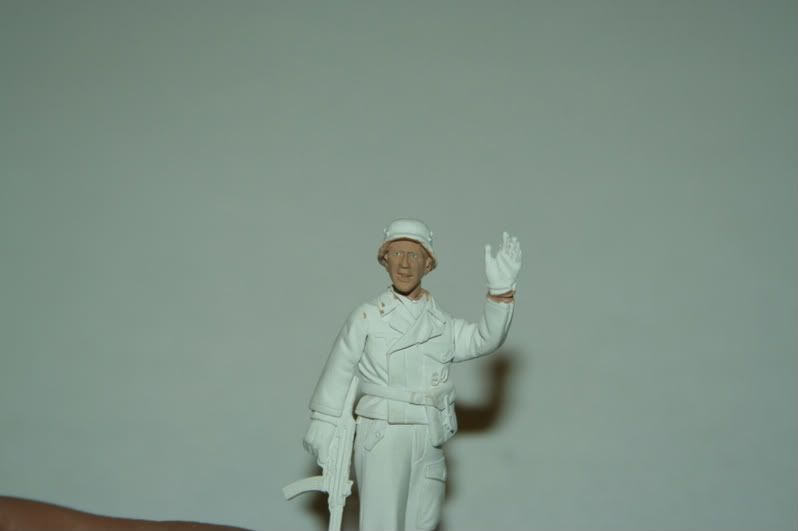
And voila - perfectly painted eyes! This worry-about-one-border-at-a-time method will apply throughout the entire basecoating process, so if you can paint eyes, you can paint anything! I'll spare you pictures of ever different color going on, and simply show you what it looks like once you're done:
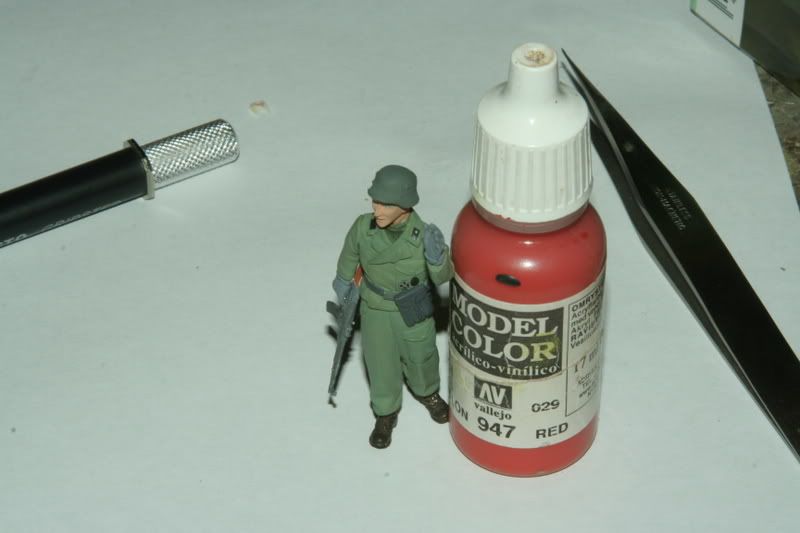
It's at this point that you'll want to add your PE details - here are a few photos of mine going on. The LionRoar German Insignia set has mind-boggling detail, even down to the '1939' on the Iron Cross! Since this set is etched in a silver-colored metal, I simply airbrushed the parts I would use with flat black, then carefully scraped the paint off the raised detail to reveal the silver color underneath. Works perfectly, looks amazing, and take only 5 minutes.
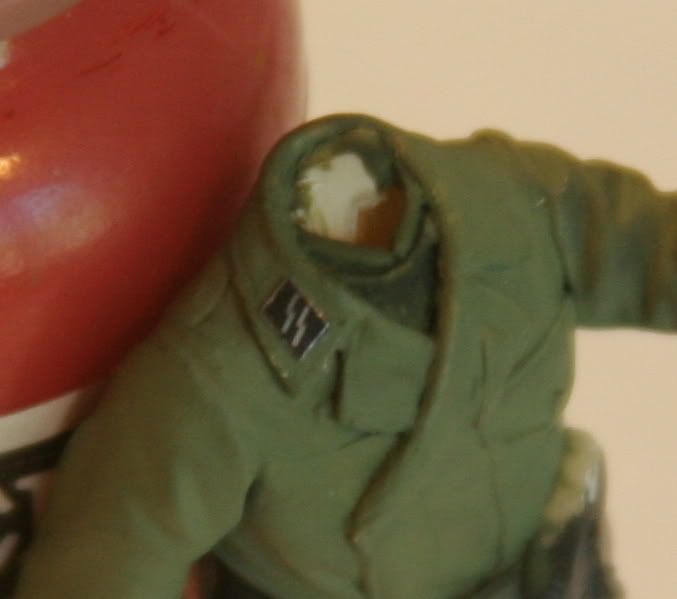
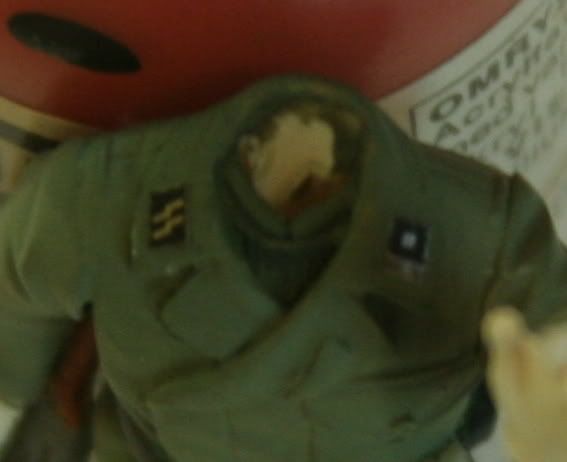
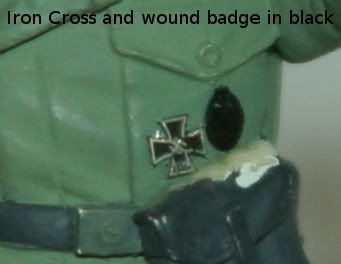
So, that pretty much covers step 2 and gives you what you'll need to paint your basecoat colors. Just remember to worry about one edge at a time as you paint detail, and not to work the paint too much. Even though you might be happy to leave your figure the way it looks now, you're not done yet! Up next is the step that really makes your figure look real - shading.